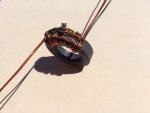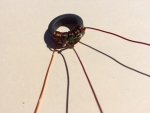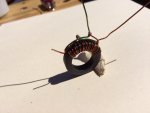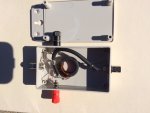Here are some plans for my favorite portable HF antenna, a resonant end fed half wave. I use an FT-114A-43 ferrite toroid (about $2 from Amidon) for a 100w version and you wind it exactly like the links with 2 turns of twisted pair for the primary and 14 turns for the secondary. I usually cross over the secondary after 7 turns as in the links but I haven't noticed any difference just doing 14 turns in a row.
PD7MAA HOMEPAGE: Multiband end fed antennas 3.5 - 30mHz
https://pa3hho.wordpress.com/end-fed-antennes/multiany-band-end-fed-english/
You will also need a 100 to 150pf capacitor across the input and I use dipped silver micas rated at 500v. Otherwise forget about any loading coil mentioned in the links and cut about 65ft of wire and trim for the best match at the low end of 40m and it will cover 40, 20, 15 and 10m without a tuner.
I also use a common mode choke and the miniature coax in the picture has about 5 turns through a large #31 ferrite bead near the radio end. The picture shows a complete 100w version with about 63ft of #22 Teflon wire and about 40ft of miniature parachute cord wound up in a plastic chalk line reel. There is a Zippo lighter next to it for size comparison and also a large dual core version that handles up to about 800w.
To use the antenna you connect the lug on the wire to the transformer box, spool out all the wire and string, then the empty chalk line reel is the throw weight to get the string side of the antenna up into a tree or whatever. Since the wire and string are very light weight it doesn't take much tension to keep the wire straight and taut.
This antenna completely kicks butt over a Buddipole, Buddistick or anything similar and it probably cost under $20 to build not including coax. If you were to feed a 40m 1/2 wave dipole with ladder line you would get the exact same radiation pattern and performance as this antenna on the bands its tuned for and you can put 1/2 wavelength of wire for 17m or 60m or any frequency and the transformer will make it work.
I usually use RG-316 miniature Teflon coax or LMR-100, both are the same size as RG-174. I use this antenna horizontal between 10 and 20ft off the ground or as a sloper with the far end as high as I can get it and the transformer near the radio.
prcguy
Edit: If you make one take a look at my smaller black transformer box and how the wing nut output stud is on the side of the box 90deg from the line of pull. This works good and if you put the output screw/stud in line with the antenna wire it will bend and weaken the lug on the antenna wire. I also have the eye ring for tying off the transformer in line with the antenna output and this puts the eye bolt in a corner of the box where its stronger and less likely to break the box apart.
PRCGUY,
Thanks again for the wealth of information and help! I am putting together a shopping list to build the balun/unun in the N6CA link you provided. It looks easy enough to build and should easily fit into some PVC tubing. Hopefully by the time the items arrive, I will be done with some household chores.
As I have been pouring over Google and different information, I stumbled across an MFJ-907. According to what I have read, it too is a matching transformer with taps. Not much to read on reviews but may be worth tinkering with. They claim it will handle 1KW. Overkill for my QRP stuff.
When you have time, yes I would be interested in the long wire antenna. Is it difficult to deploy? does it sag in the middle? How high off the ground do you use it? I have lots of cat 5 stuff thanks to my work, mostly patch cables but might be able to locate a short spool of cat5 plant cable.
When I do get around to testing my AH-703, I may try to examine if it has the loading coil along with my other mobile antennas. I even have a Kenwood MA-5 antenna. Found it in a parts bin and didn't even know what it was. My original plan was to mimic the original Icom counterpoise but may use 4 wires instead of two. I have the Icom backpack and at some point, may run over to Destin and give it a try. Europe used to boom in over there in the afternoon on 40 Meters when I would take my son to soccer. Since he is starting collage, I am finding more time for my radio stuff. I miss Aerocom....
Regards,
John
N4WII








